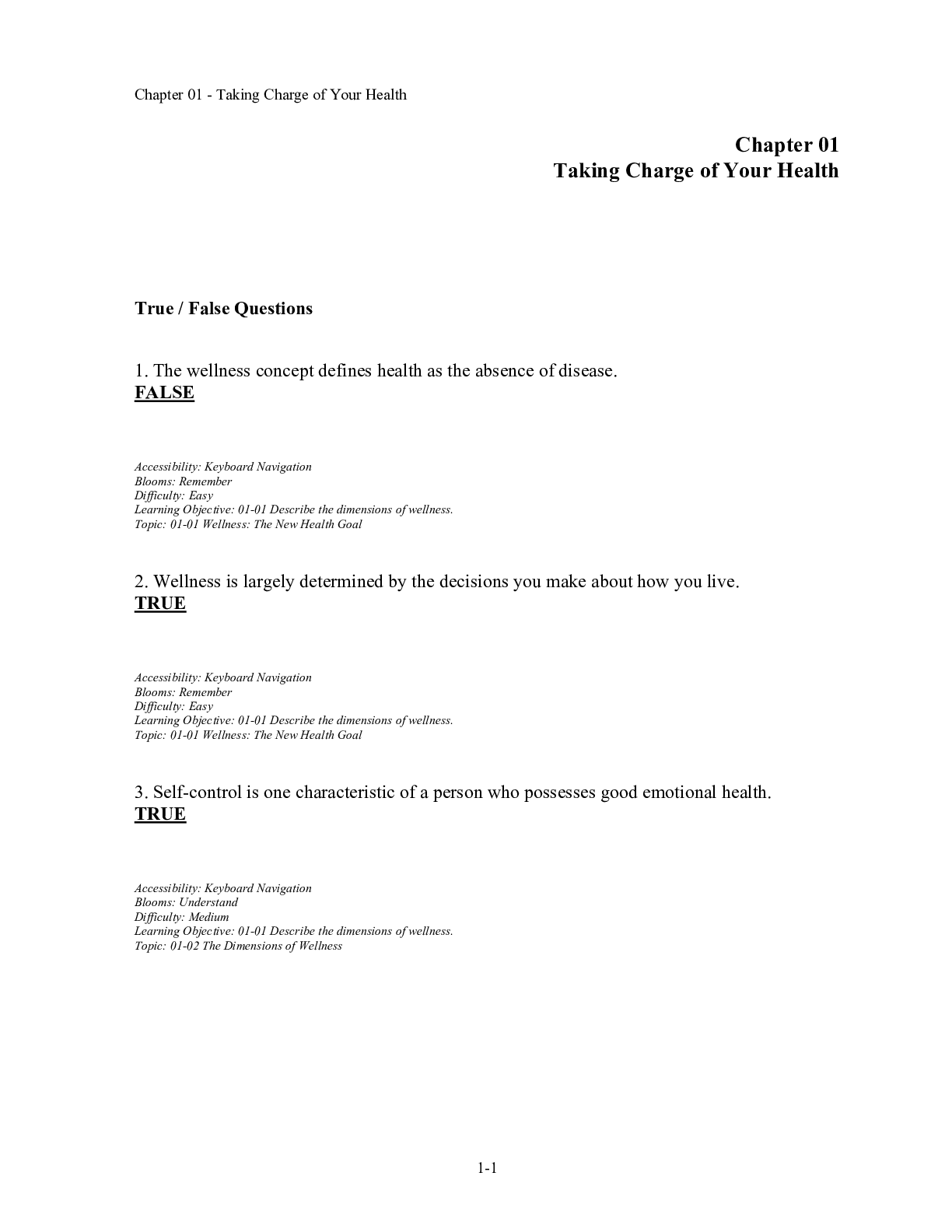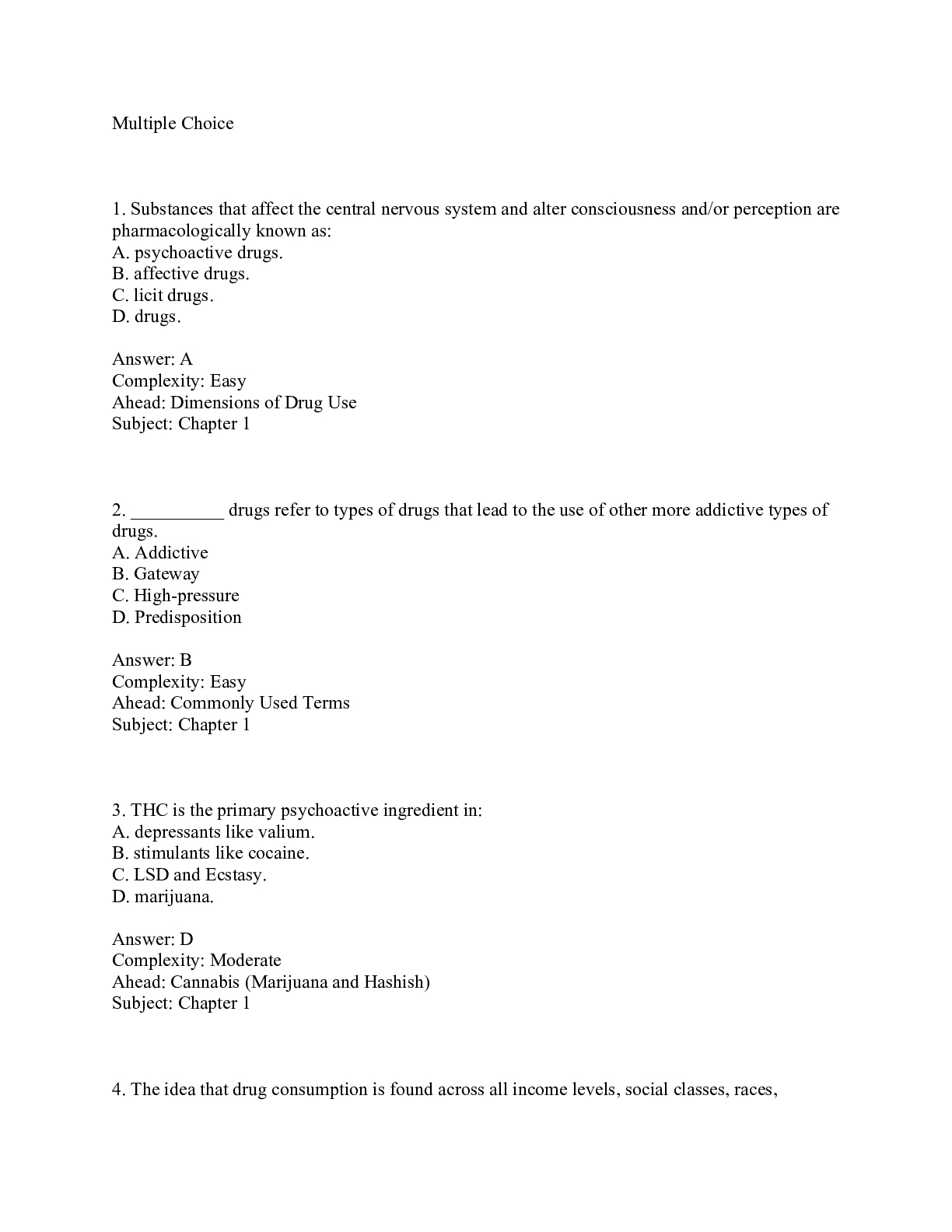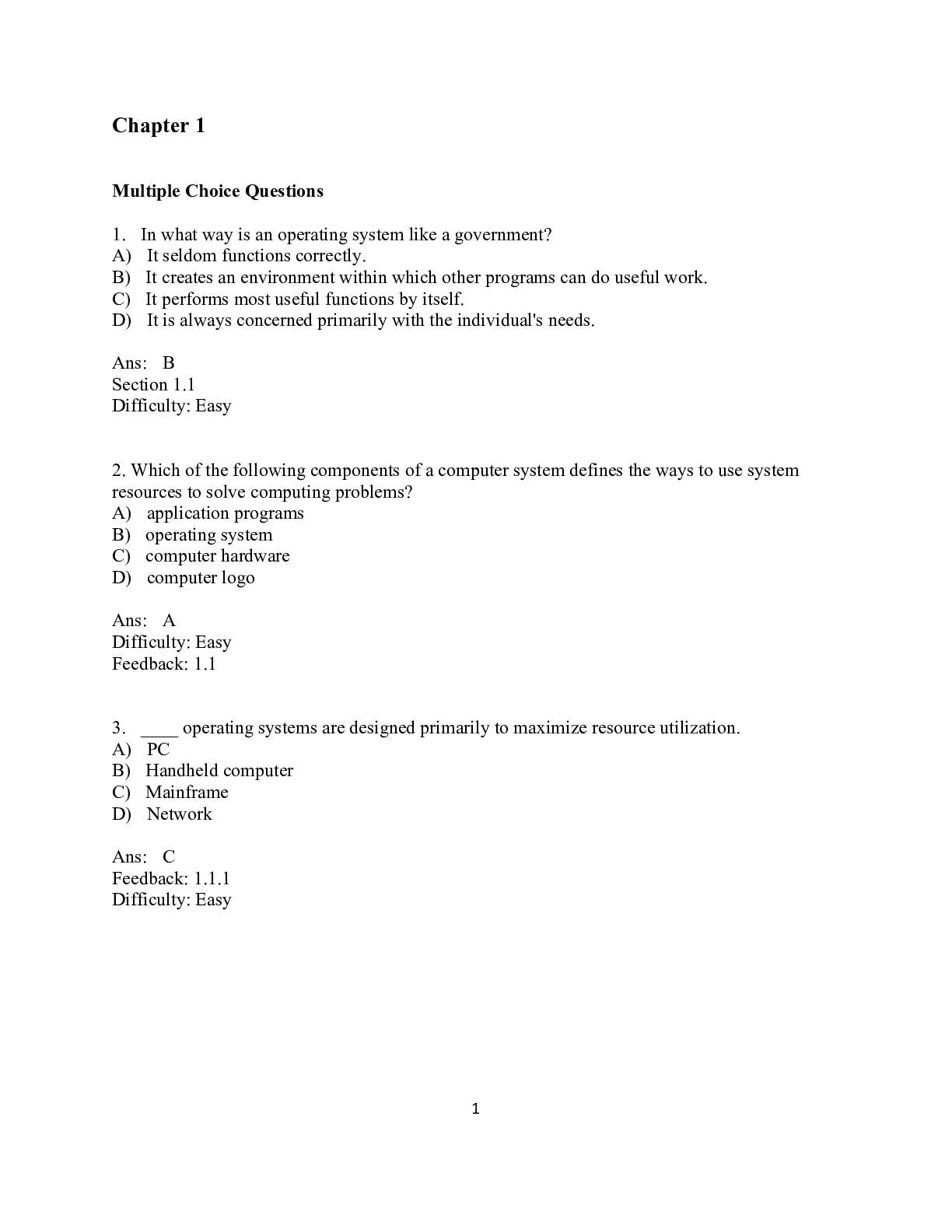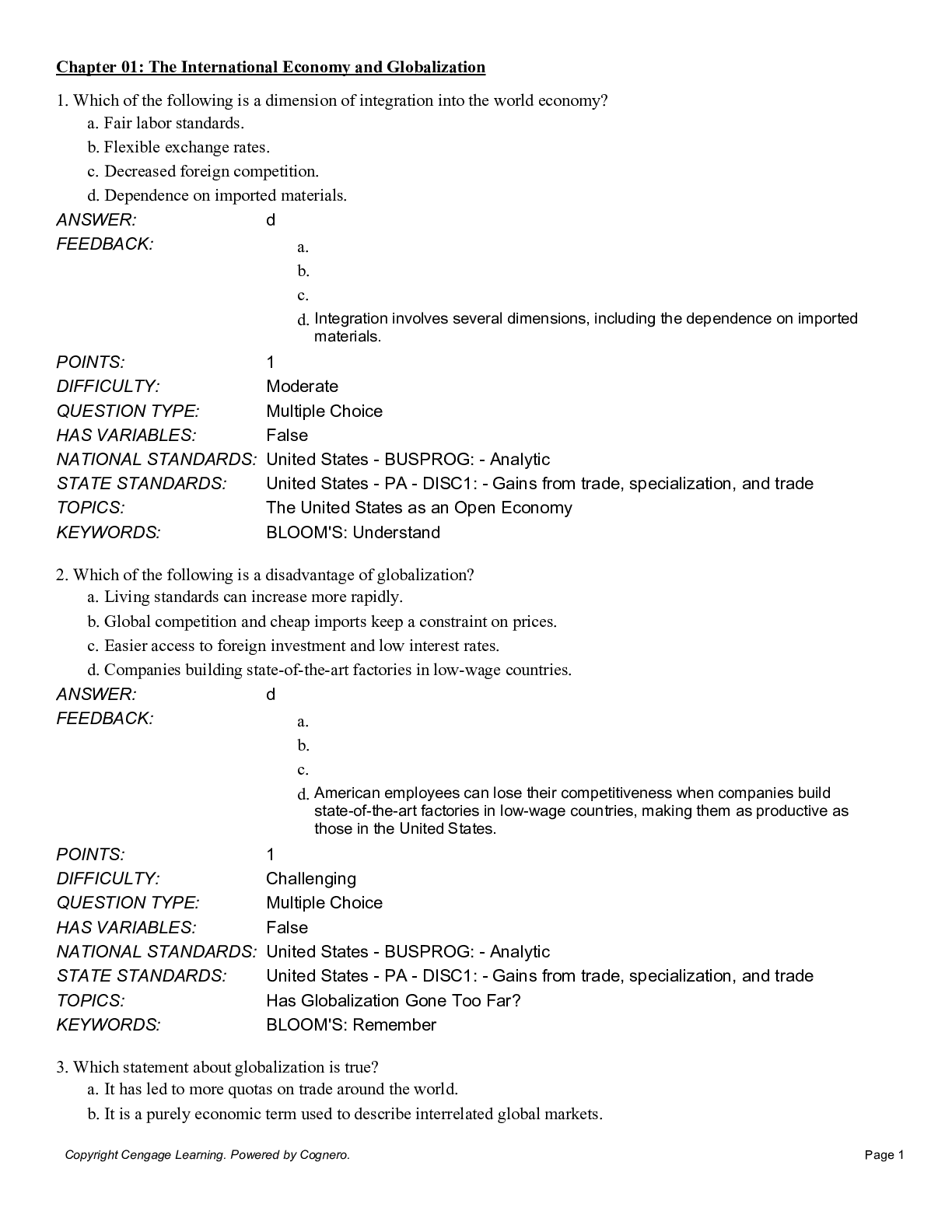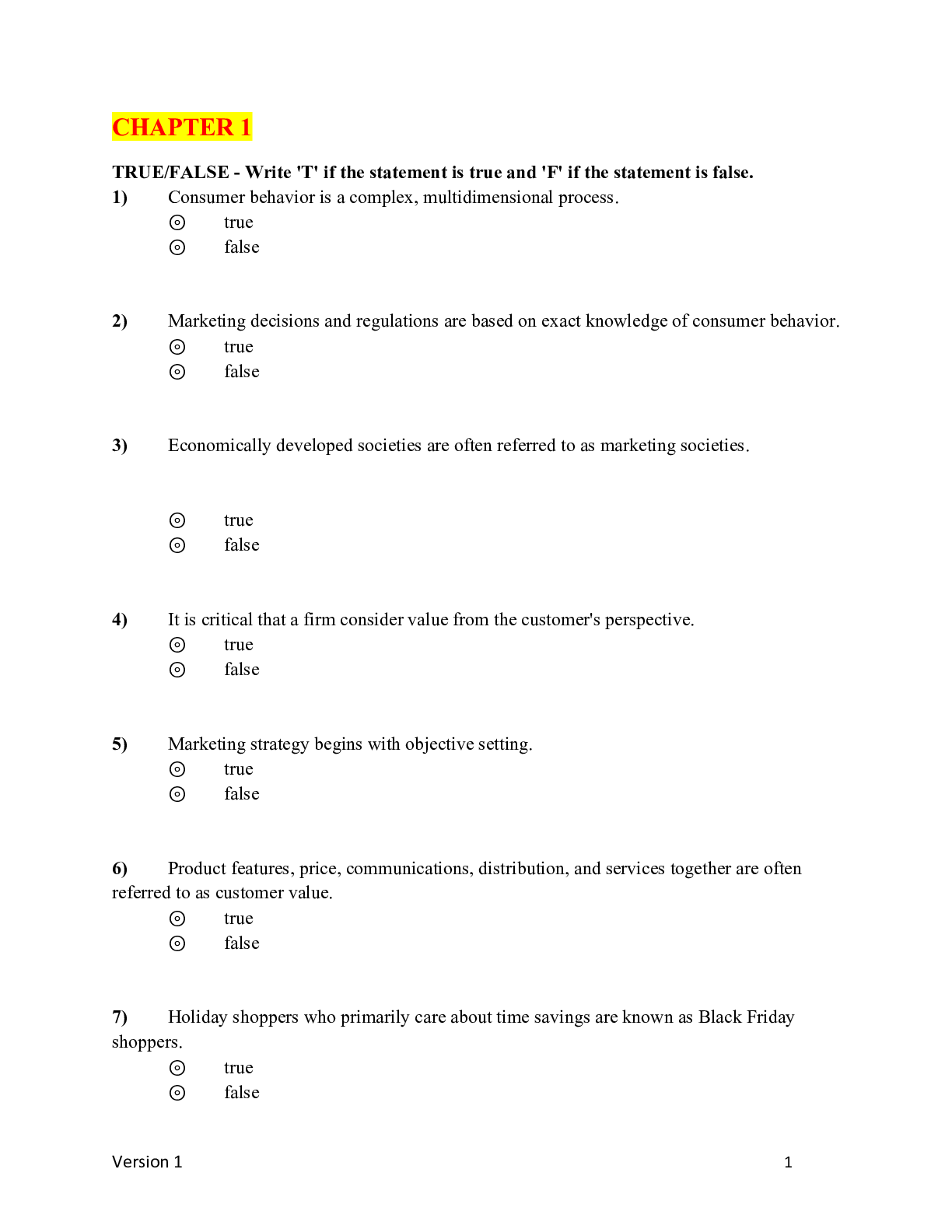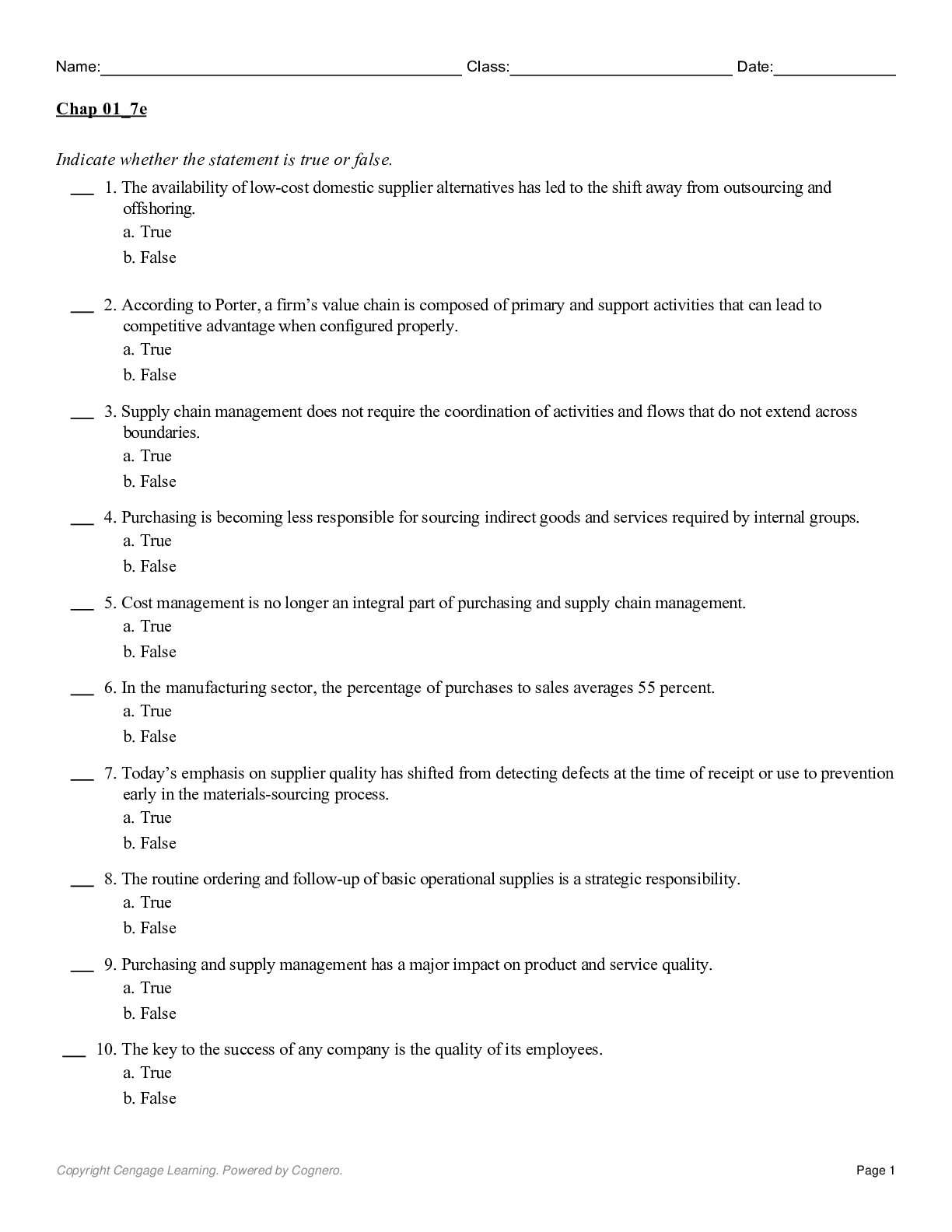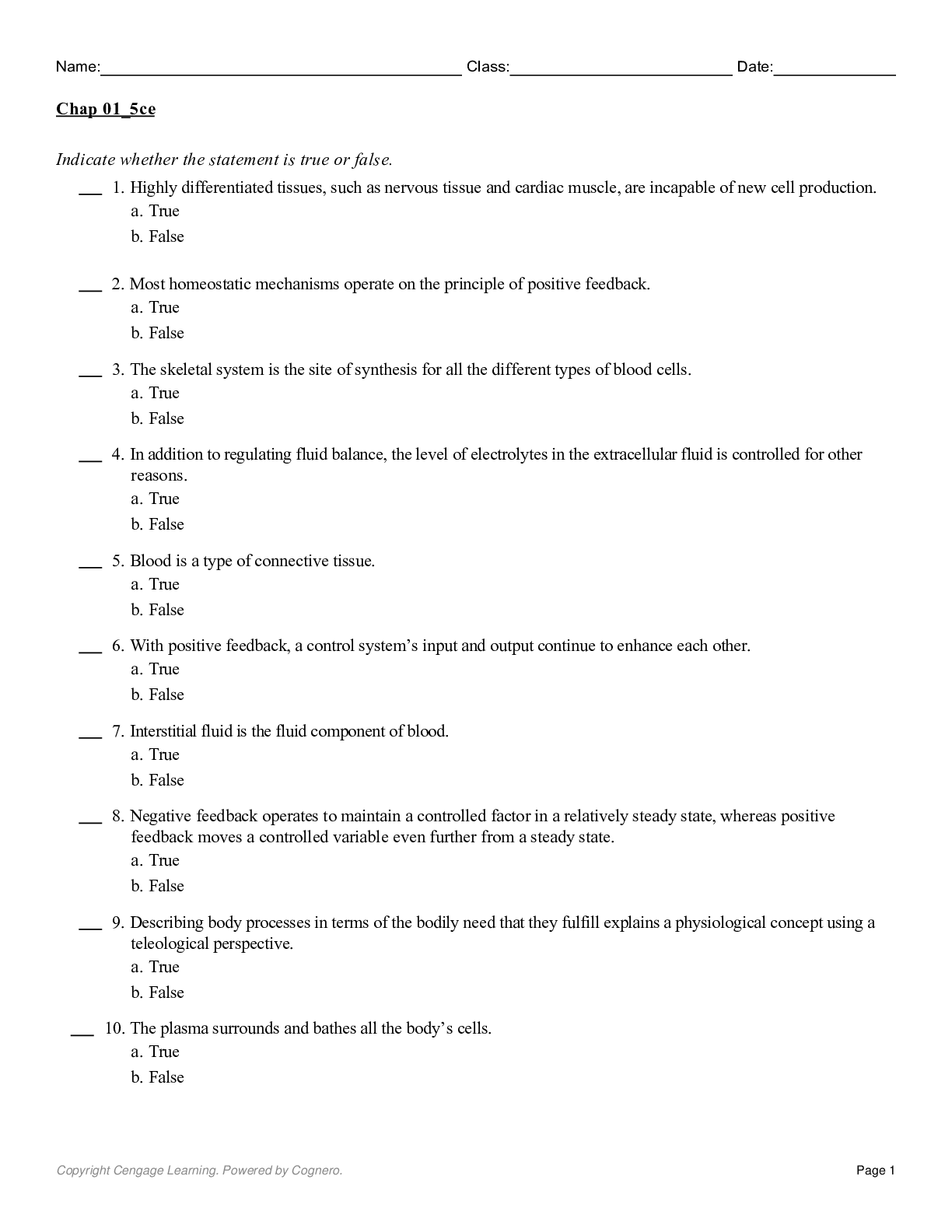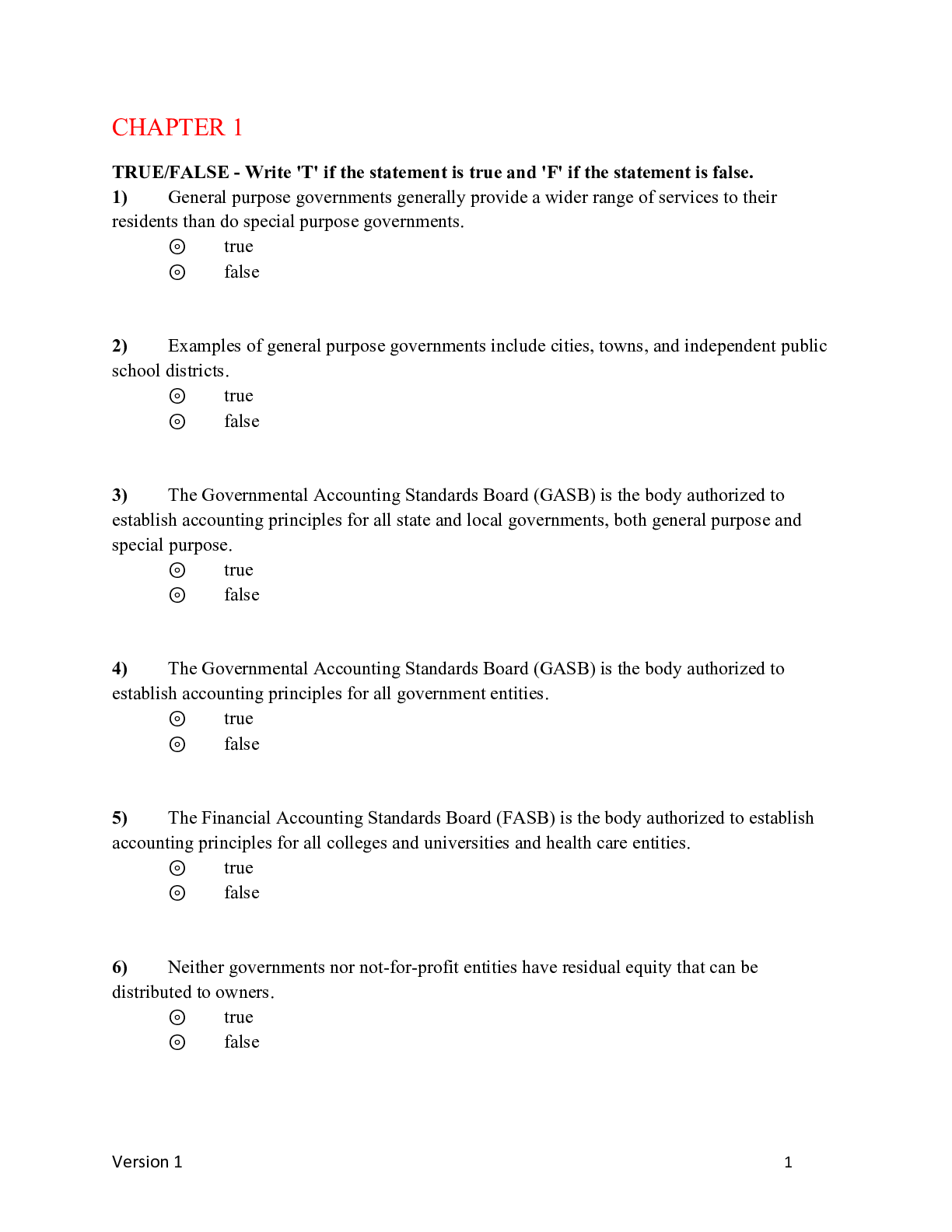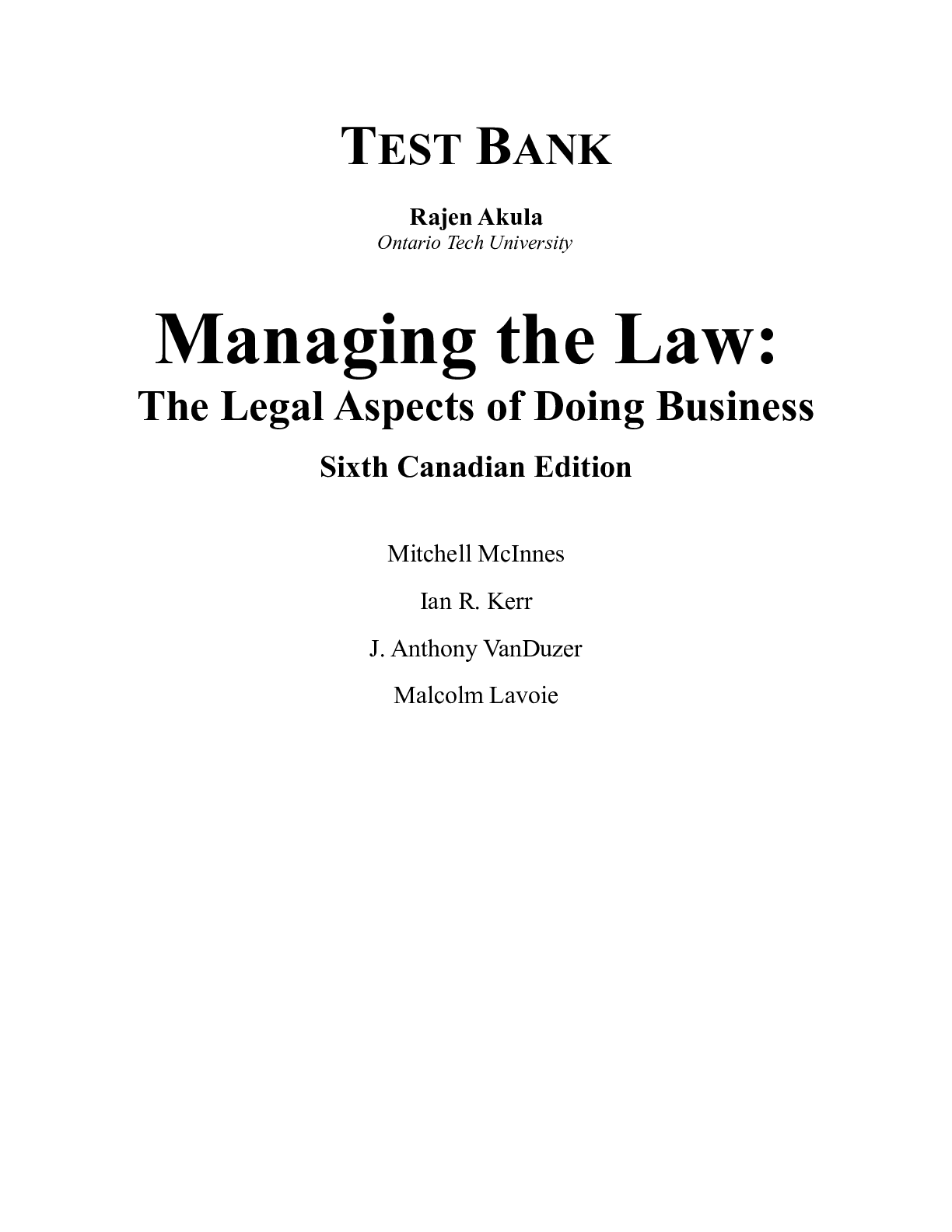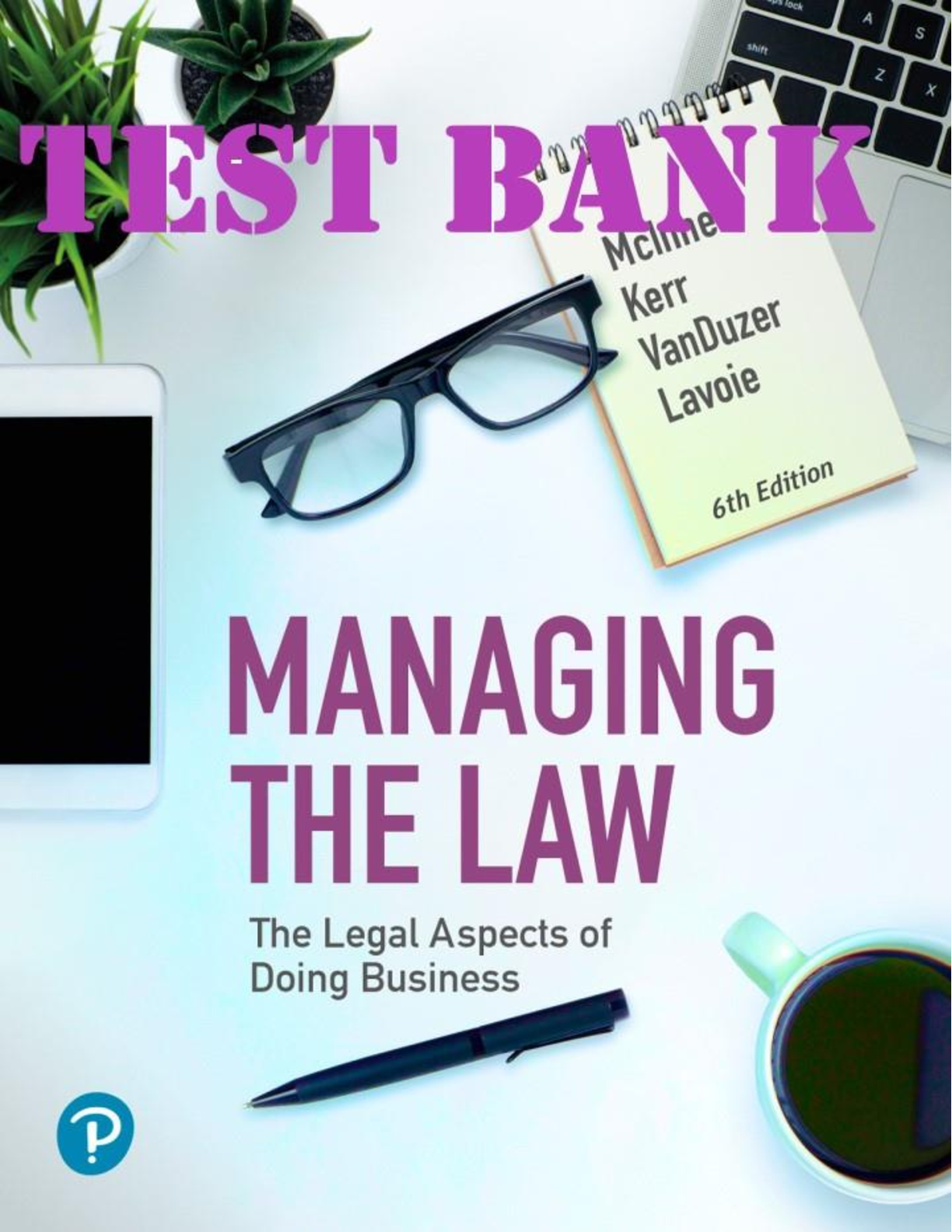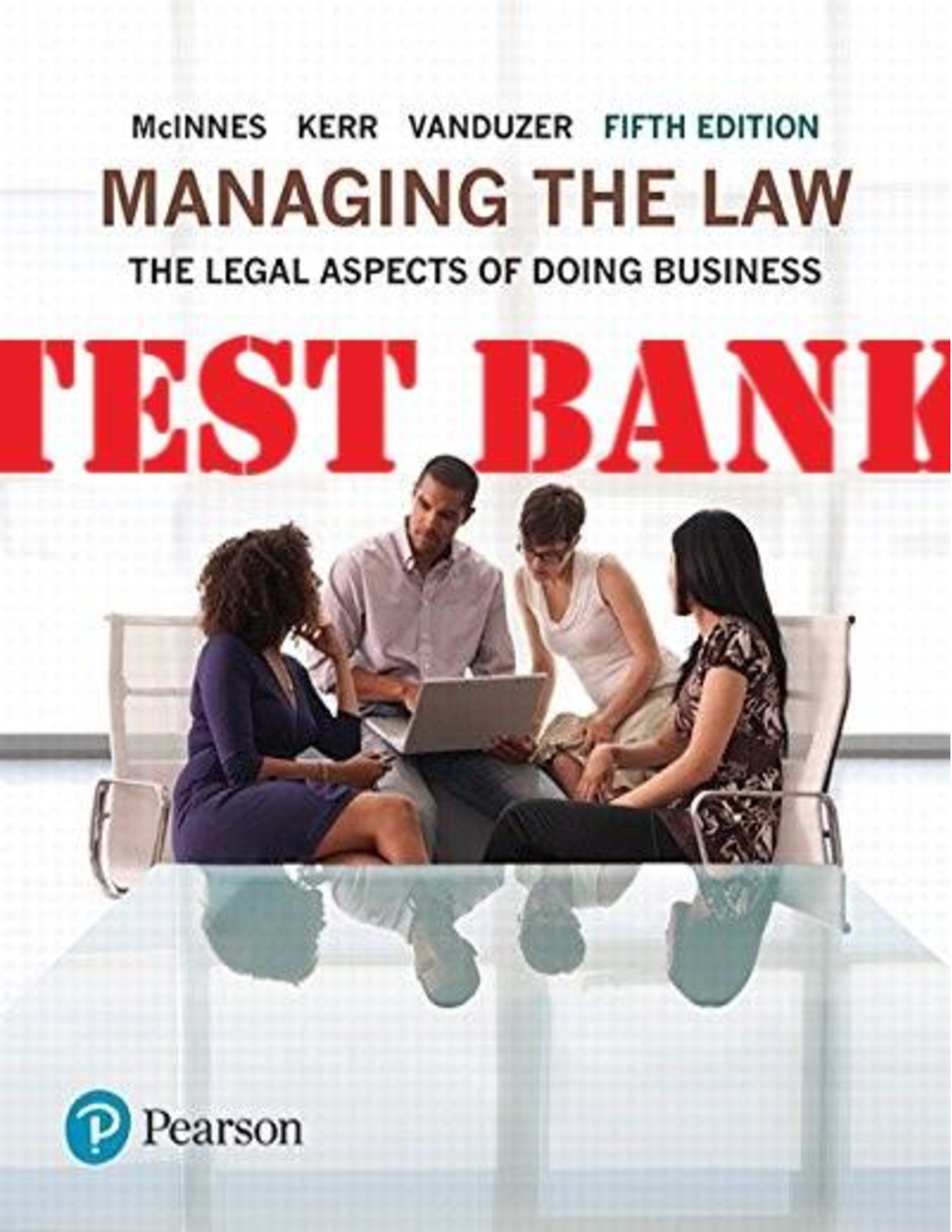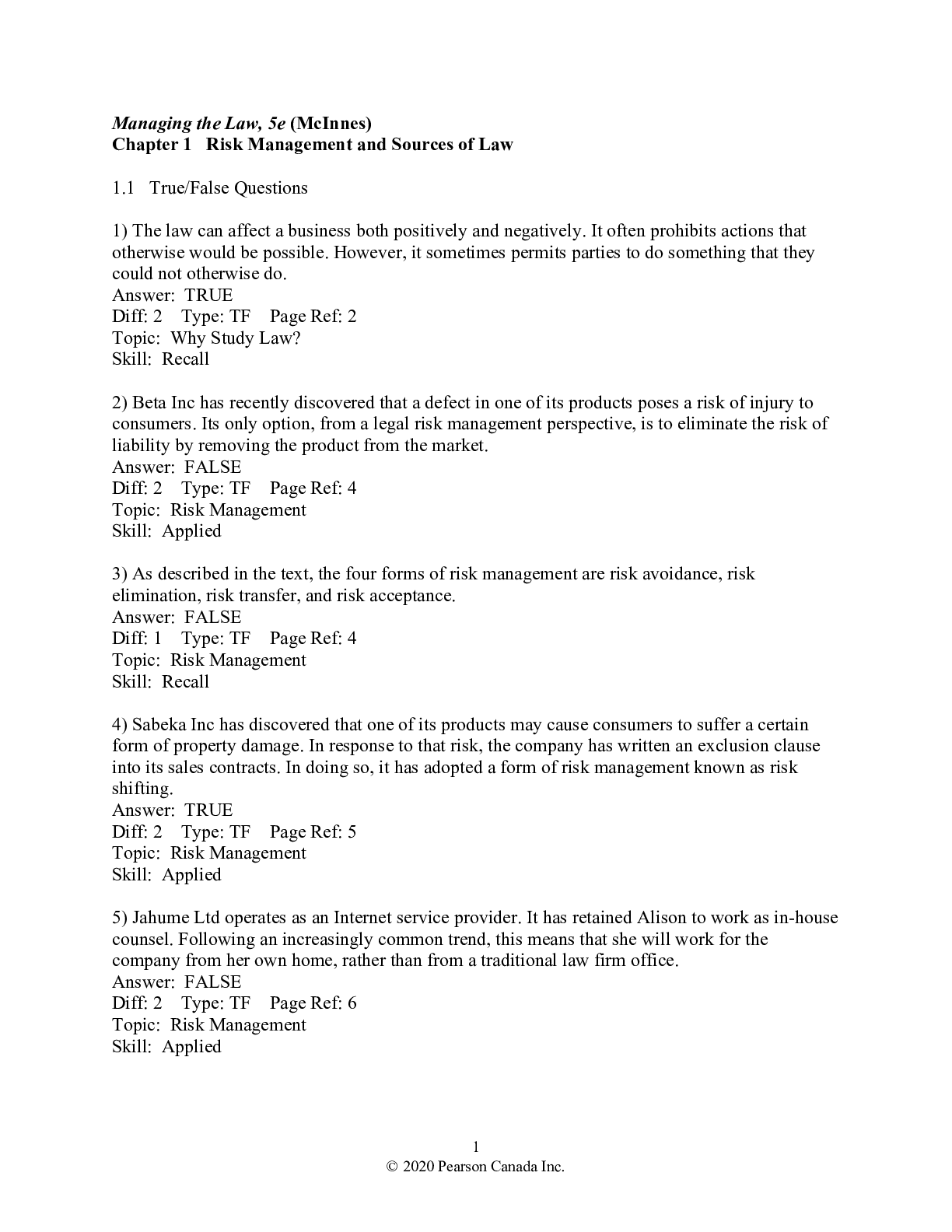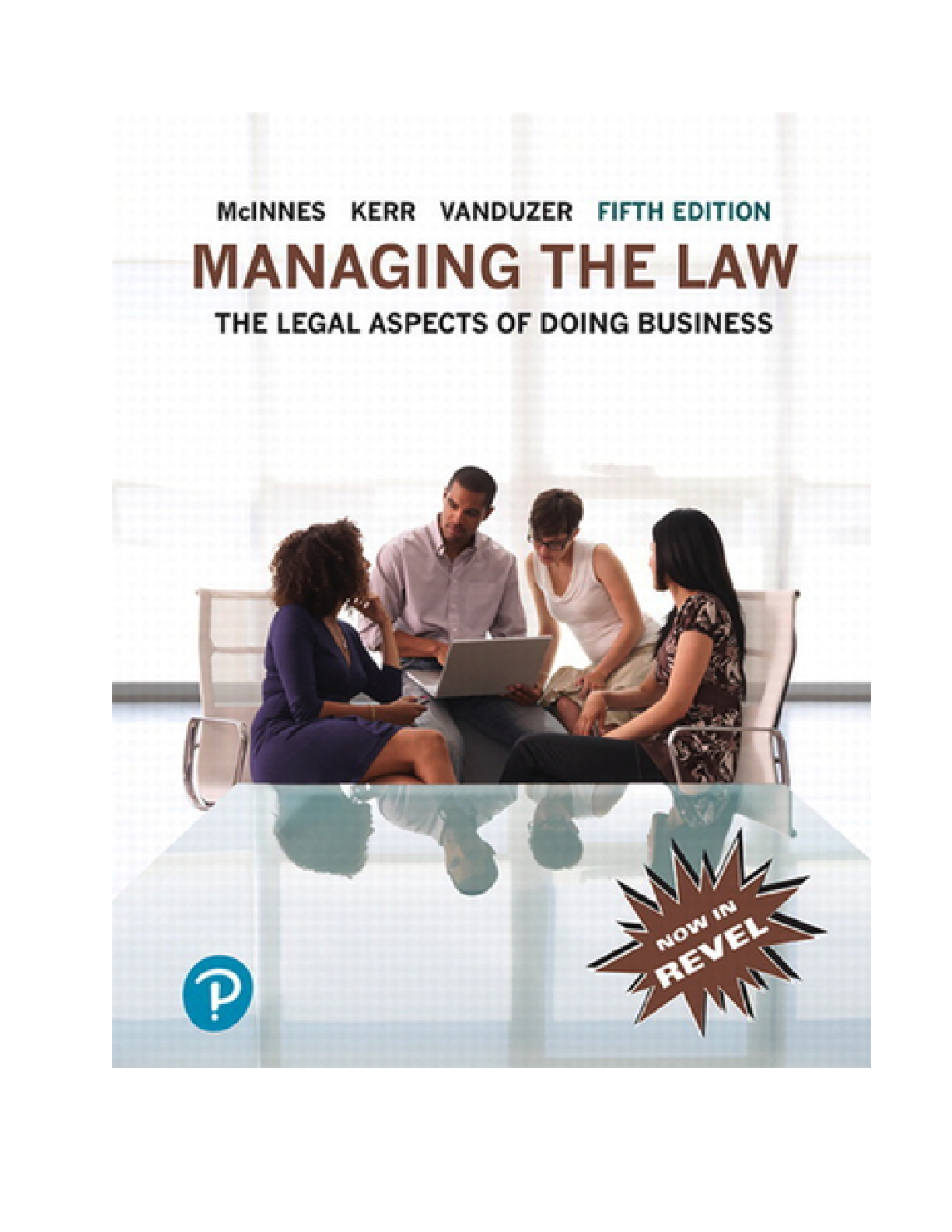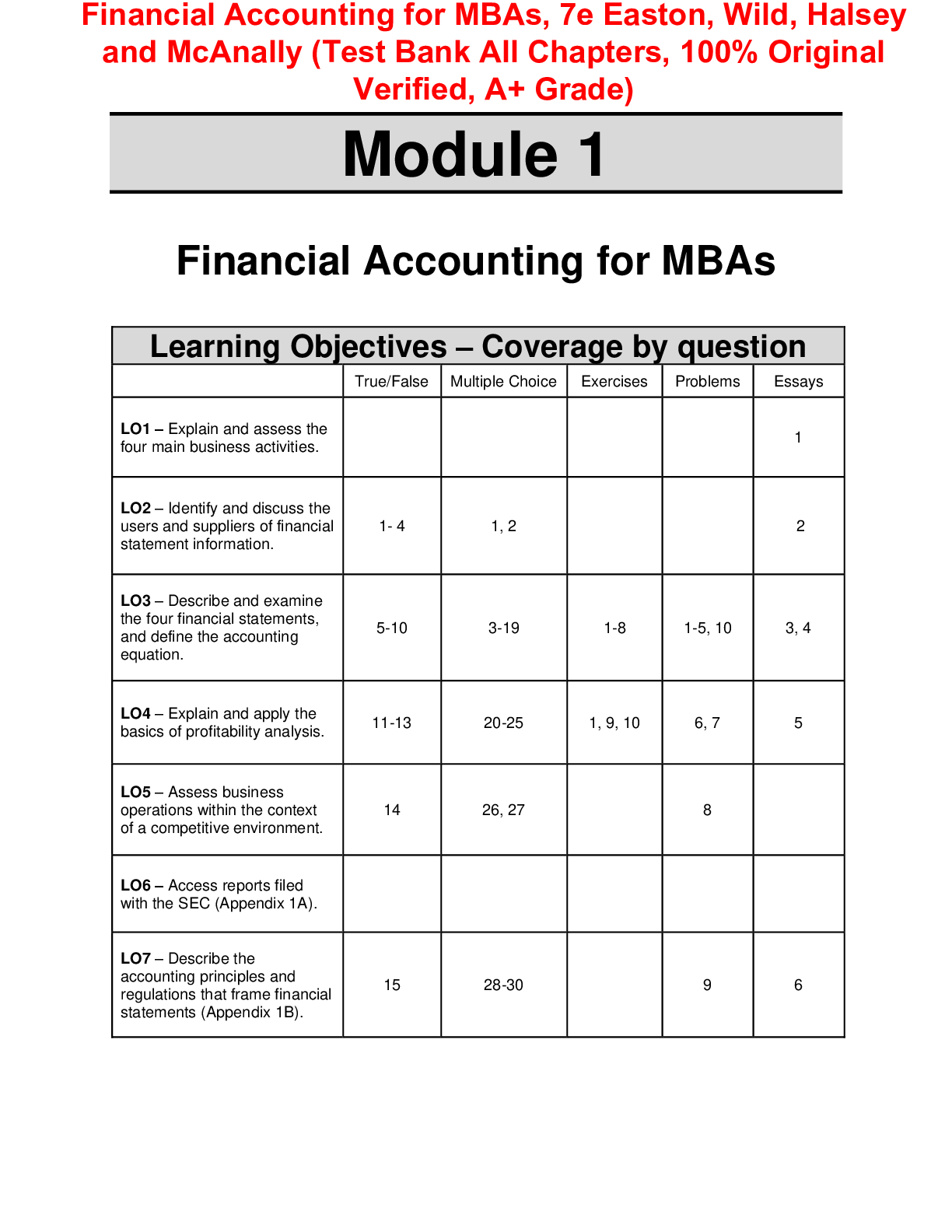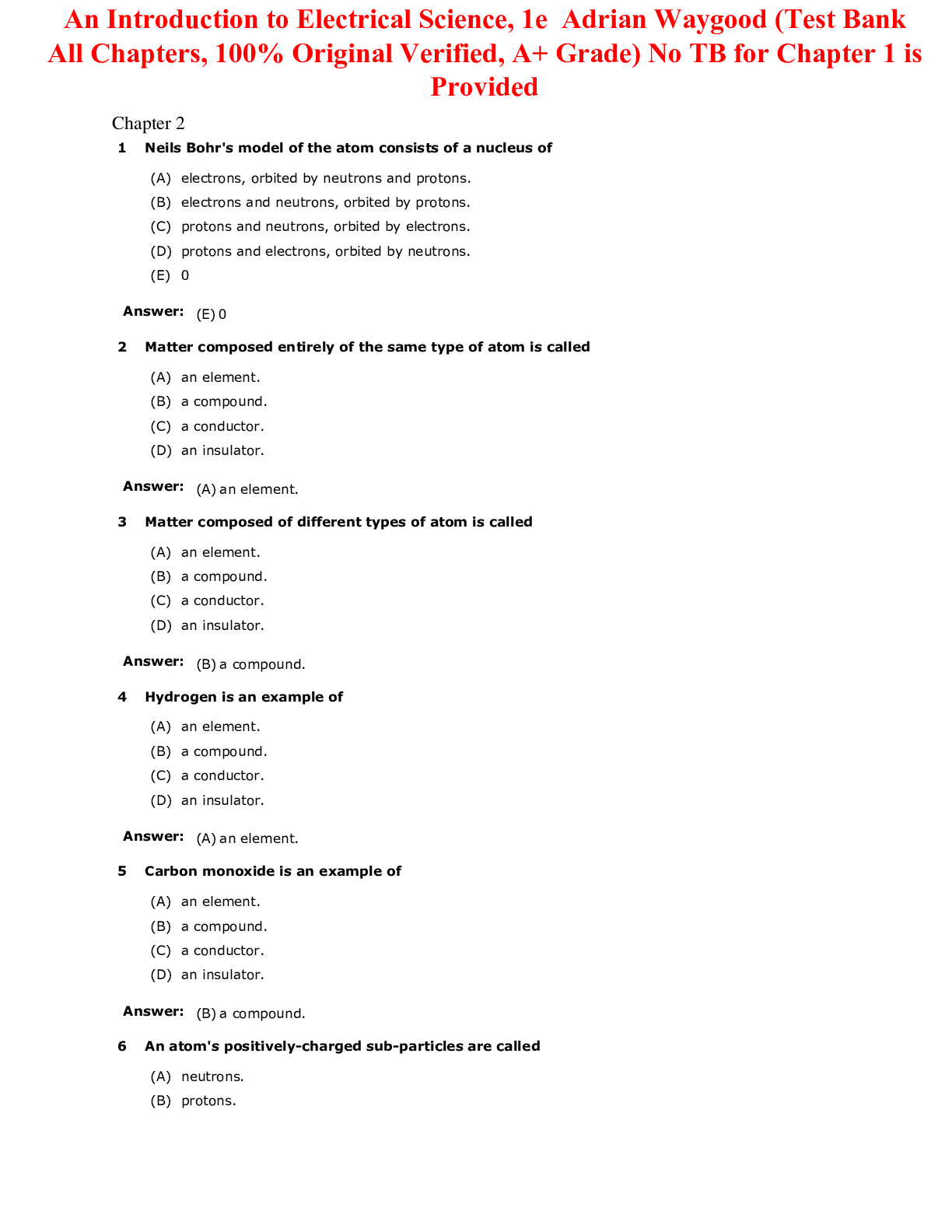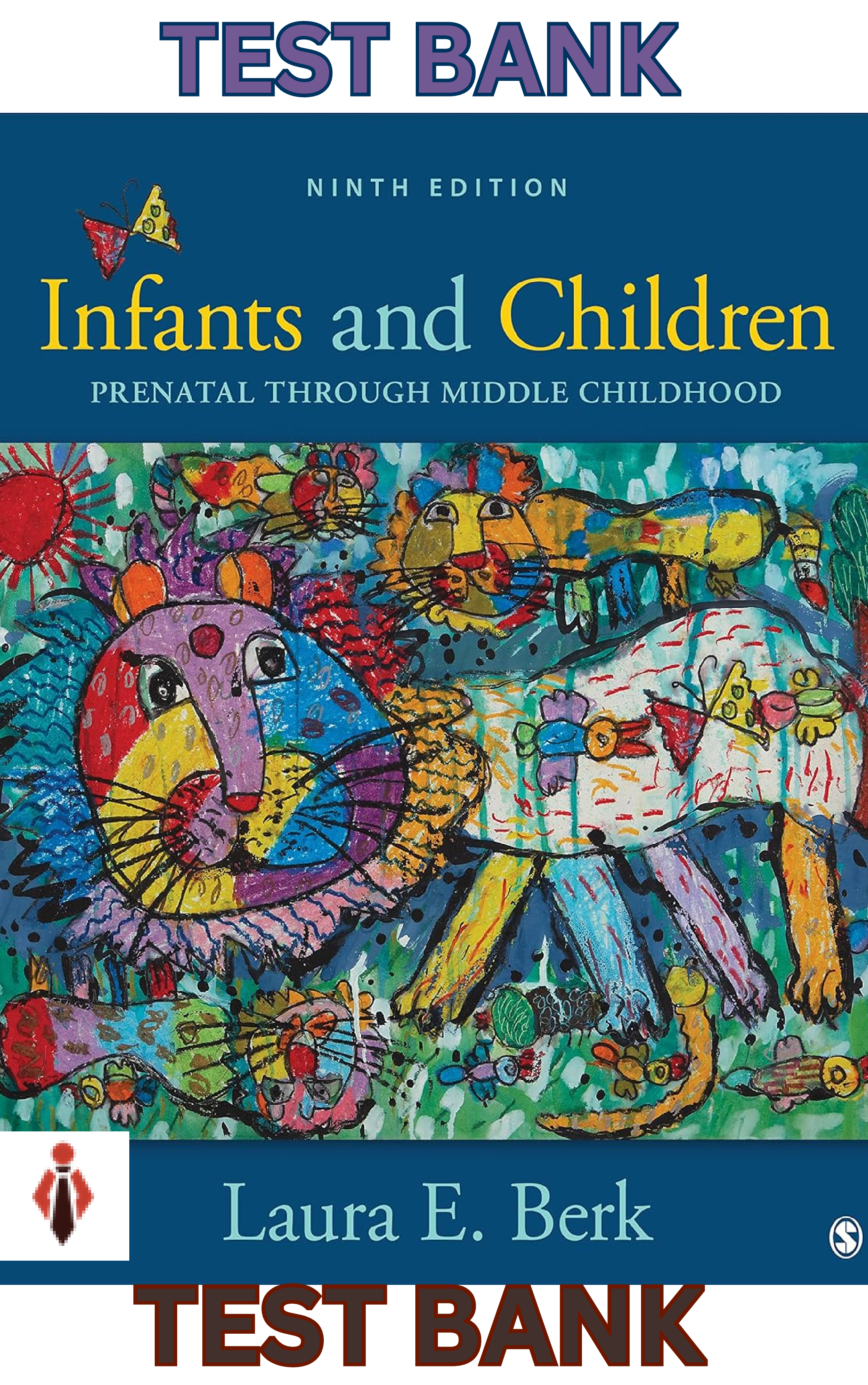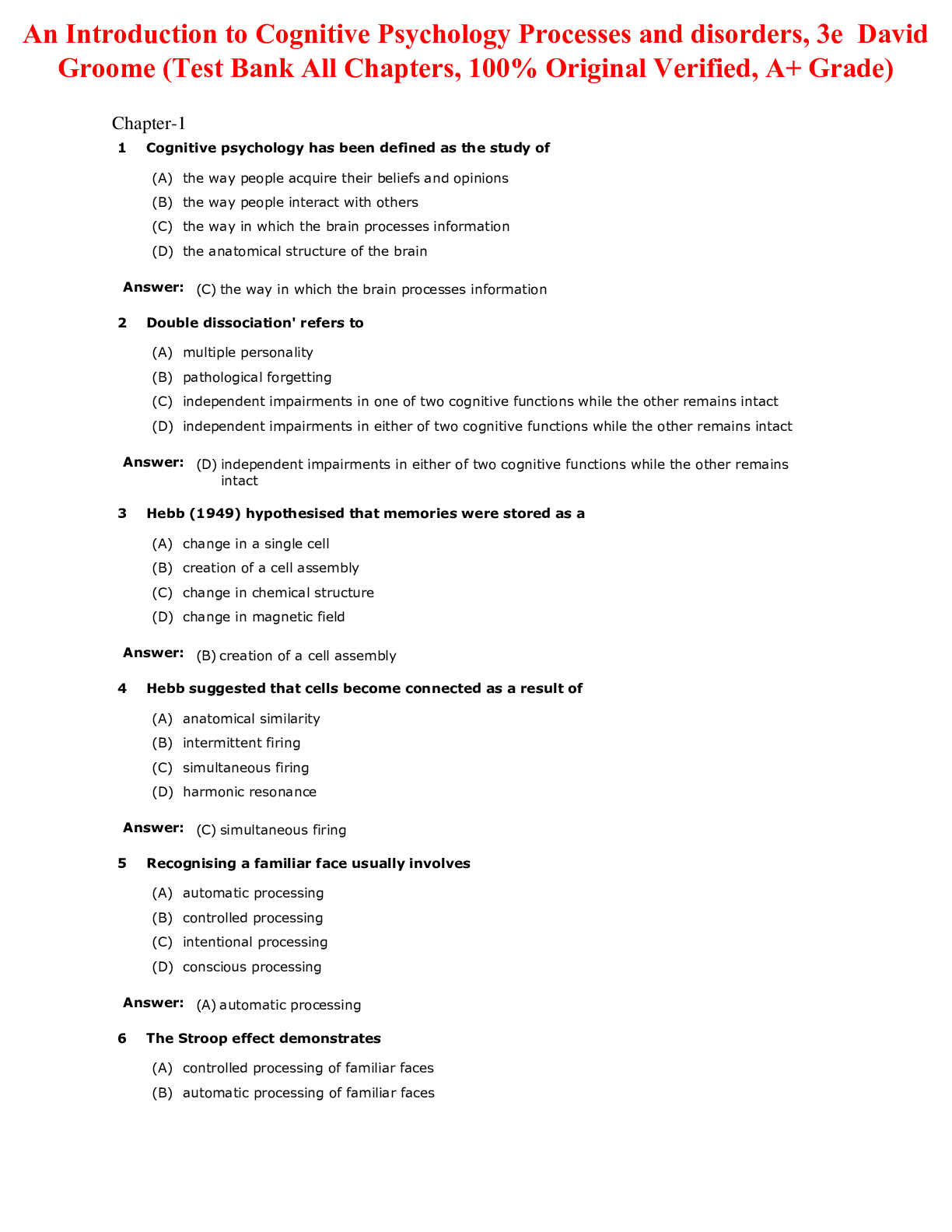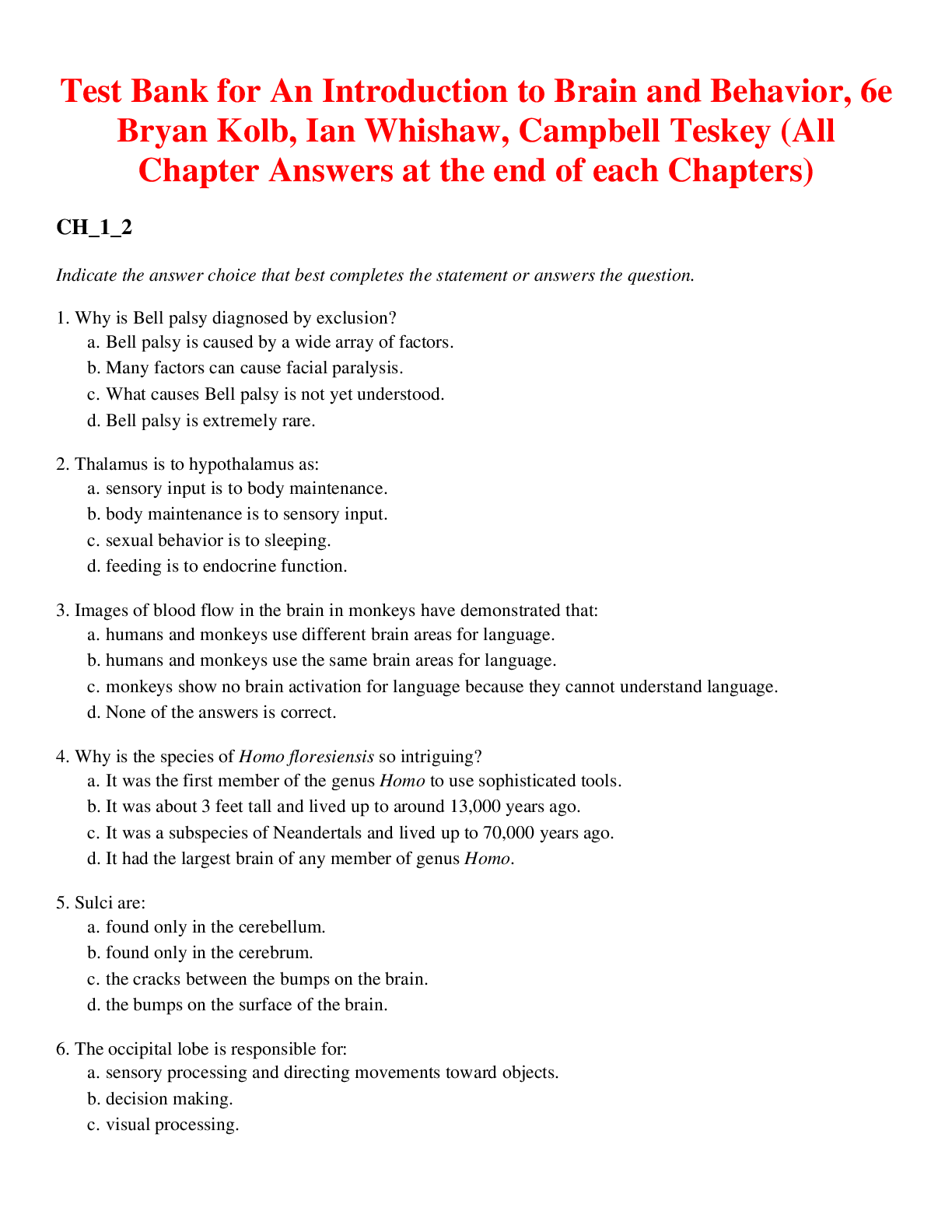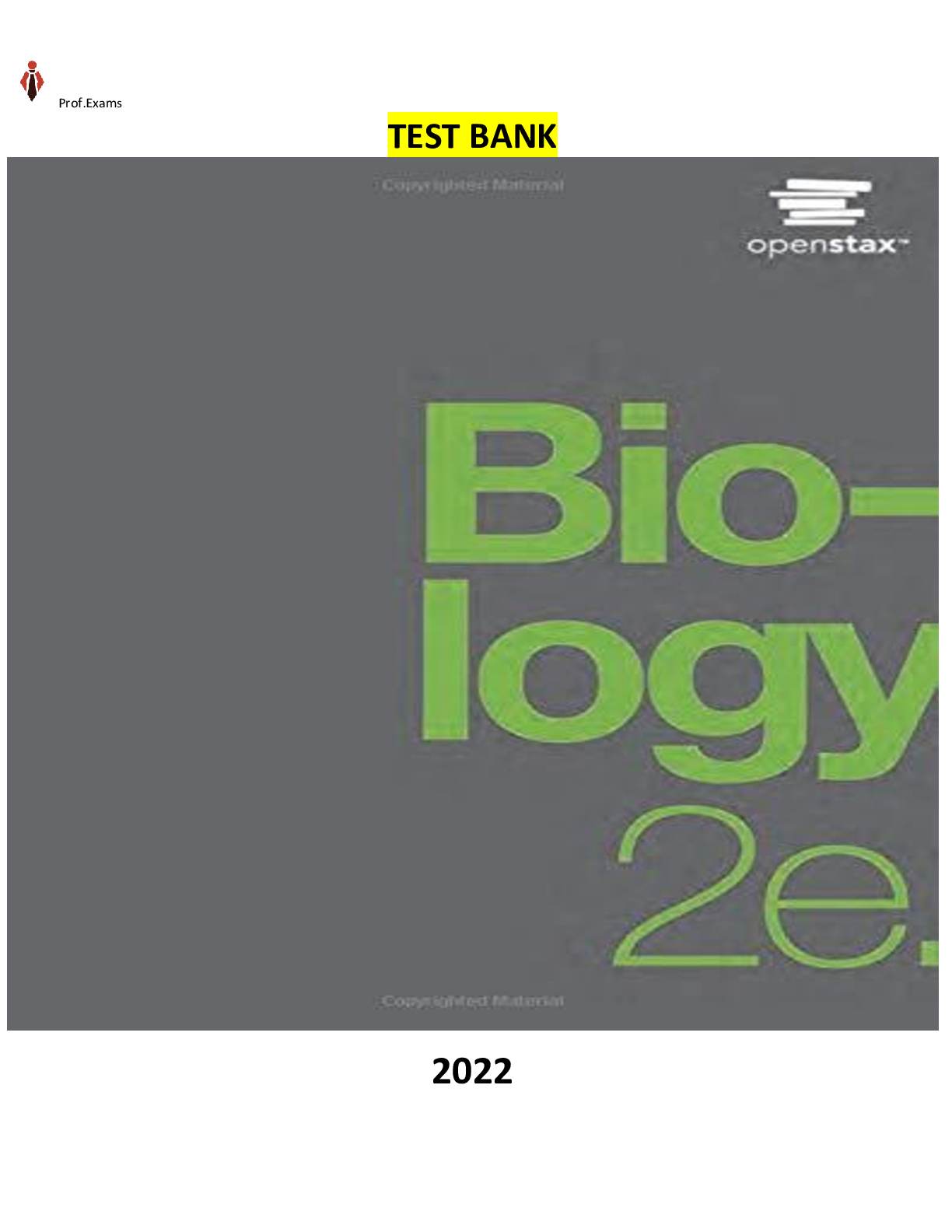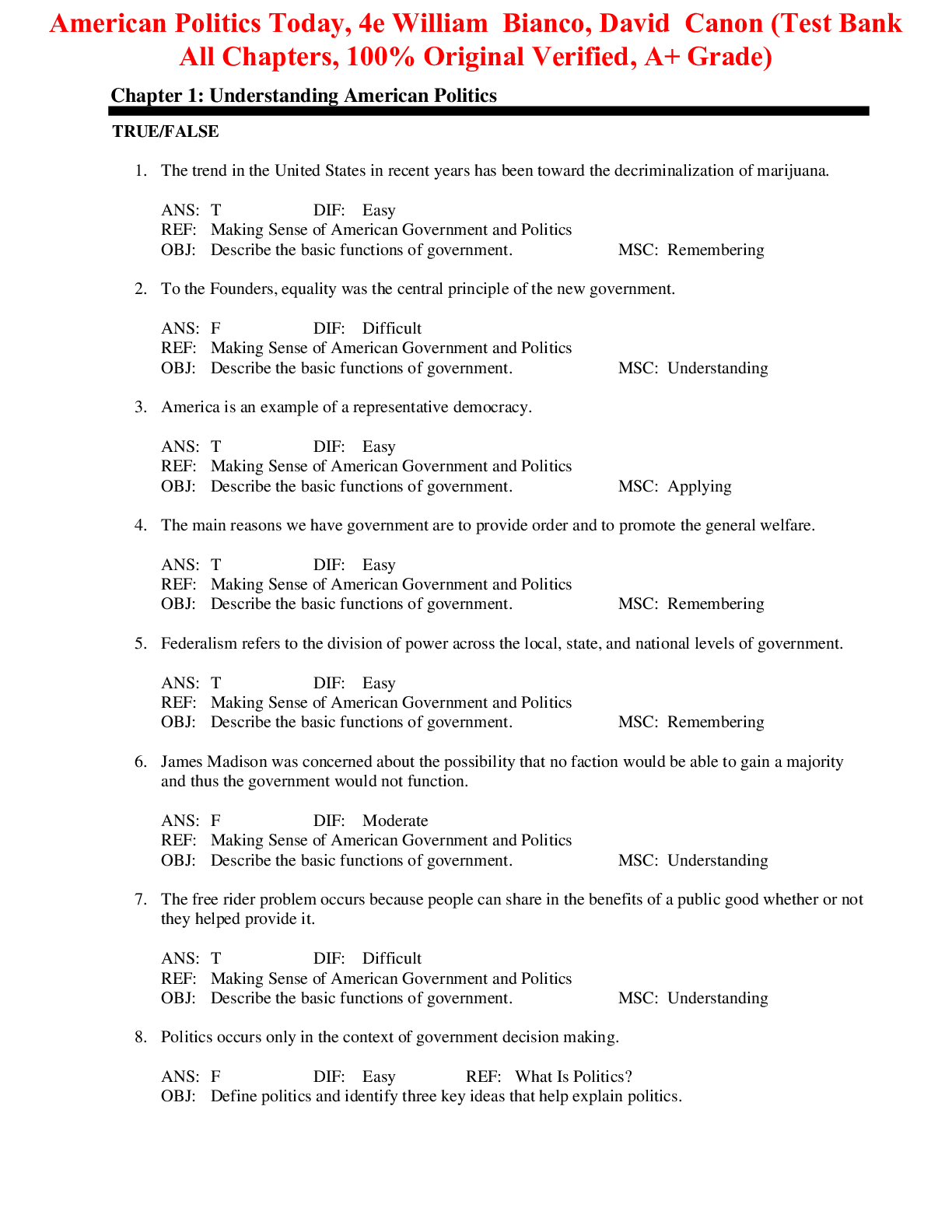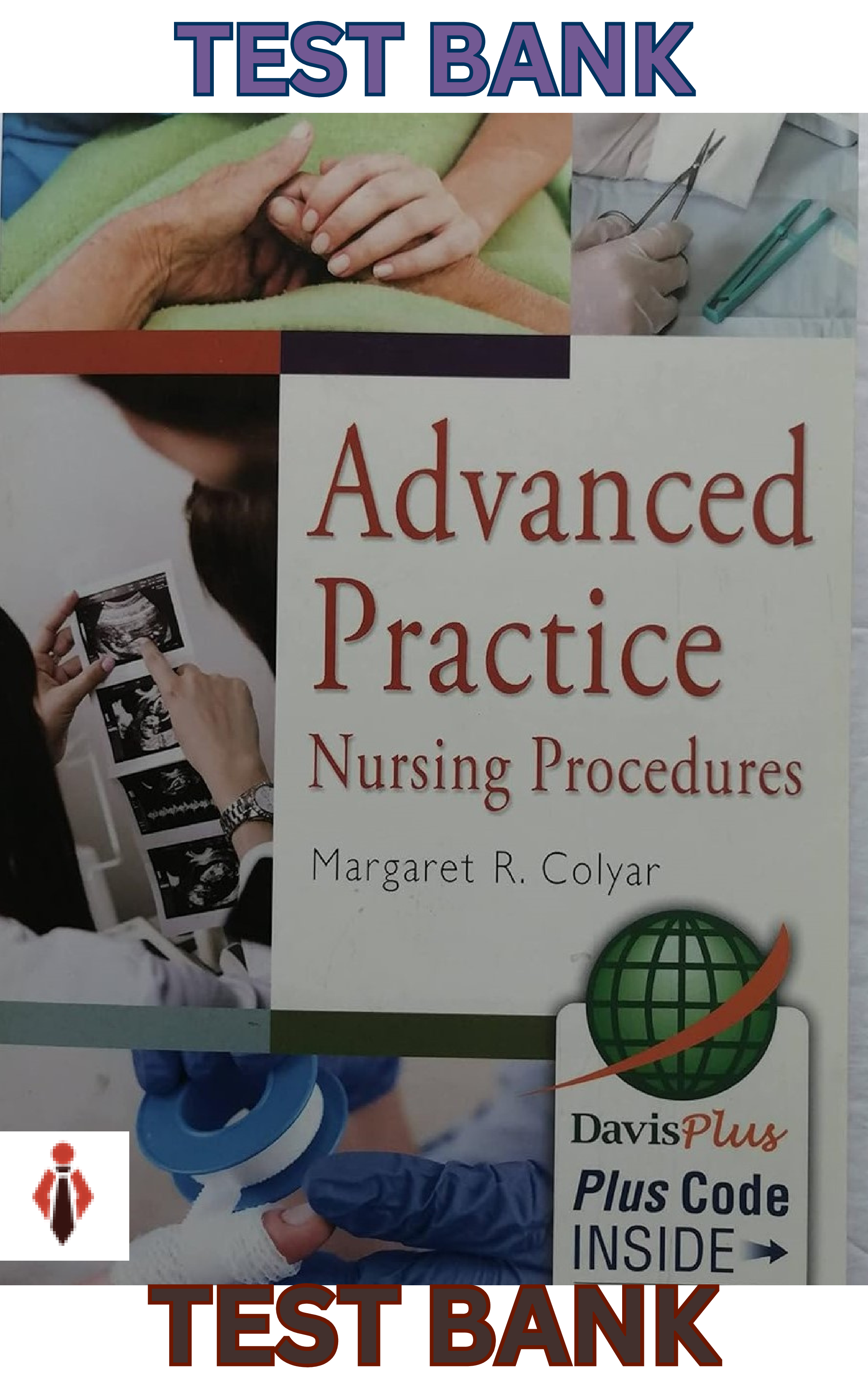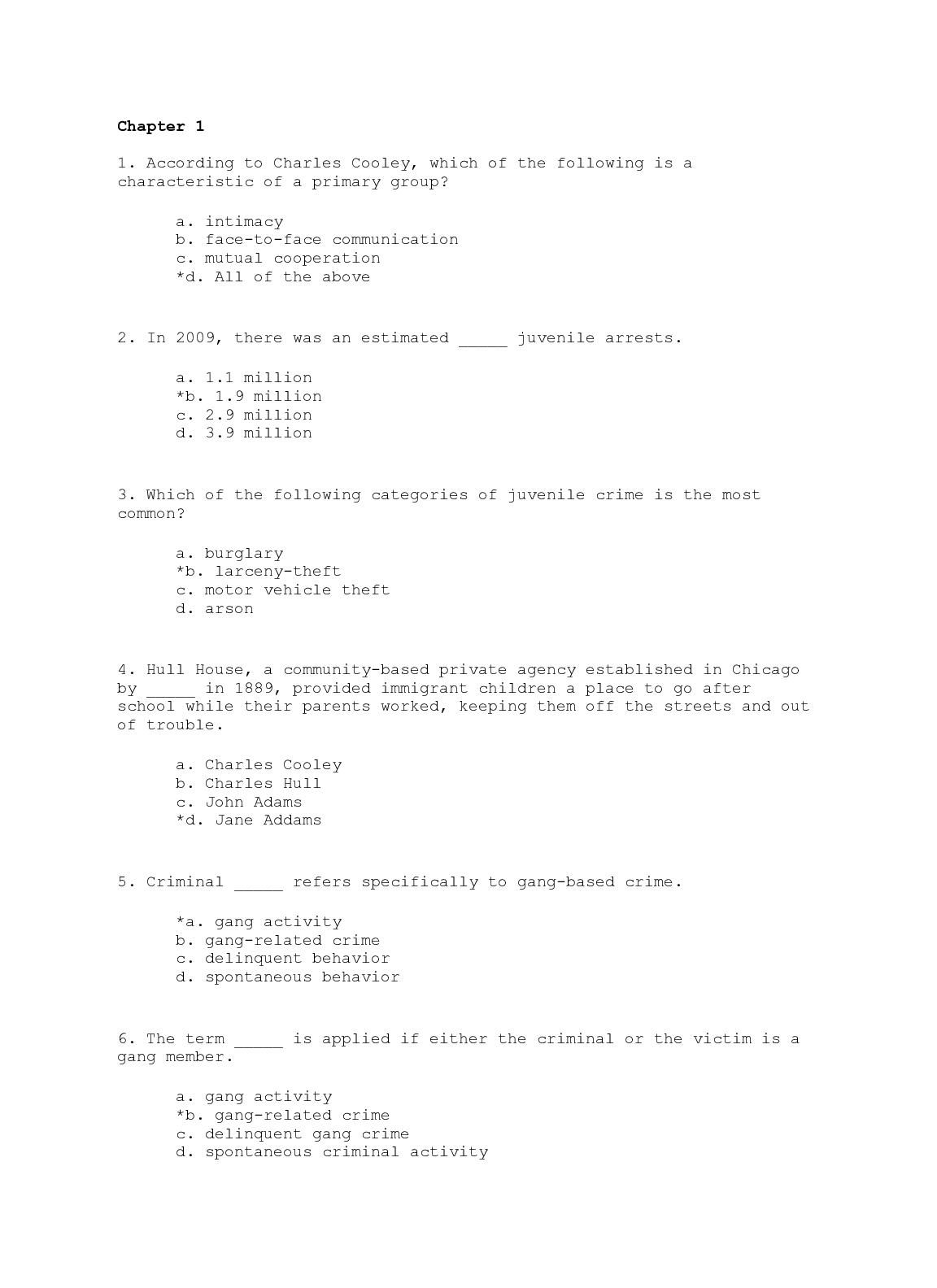Law > TEST BANK > Managing the Law The Legal Aspects of Doing Business, 6th C E by McInnes Test Bank (All)
Managing the Law The Legal Aspects of Doing Business, 6th C E by McInnes Test Bank
Document Content and Description Below
Test Bank for Managing the Law The Legal Aspects of Doing Business, 6th C E, 6th Canadian Edition by Mitchell McInnes,Ian R. Kerr,J. Anthony VanDuzer TEST BANK ISBN-13: 9780137845941 Full chapters i... ncluded Chapter 1 Risk Management and Sources of Law Learning Objectives 1.1 Why Study Law? Risk Management: Analysis Risk Management: Strategies Risk Management: Techniques 1.2 The Nature of Law A Map of the Law: Introduction A Map of the Law: Public Law A Map of the Law: Private Law A Map of the Law: Overlap 1.3 Sources of Law The Constitution: Introduction The Constitution: Division of Powers Tax Law Charter of Rights and Freedoms: Introduction Charter of Rights and Freedoms: Restrictions Charter of Rights and Freedoms: Remedies Indigenous Rights: Introduction Indigenous Rights: The Duty to Consult Legislation The Legislative Process Subordinate Legislation and Municipalities The Courts: Introduction The Courts: The Common Law The Courts: Law and Equity Trusts Chapter Summary Review Questions Cases and Problems Chapter 2 Litigation and Alternative Dispute Resolution Learning Objectives 2.1 The Litigation Process Who Can Sue and Be Sued? Class Actions Legal Representation Self-Representation Lawyers Paralegals Pleadings Pre-Trial Activity The Trial The Remedy Enforcement Appeals Costs Contingency Fees 2.2 The Court System Supreme Court of Canada Court of Appeal Superior Court Federal Court Provincial Court Provincial Court—Small Claims Courts Court Hierarchy 2.3 Alternatives to the Courts Administrative Tribunals Alternative Dispute Resolution Negotiation Mediation Arbitration Chapter Summary Review Questions Cases and Problems Part 2 Torts Chapter 3 Introduction to Torts Learning Objectives 3.1 Introduction to Tort Law Torts and Crimes Torts and Contracts Types of Torts Strict Liability 3.2 Concepts Associated with Tort Law Liability Insurance Vicarious Liability 3.3 Tort Remedies Compensatory Damages Remoteness Mitigation Punitive Damages Nominal Damages Injunctions Alternative Compensation Schemes Chapter Summary Review Questions Cases and Problems Chapter 4 Intentional Torts Learning Objectives 4.1 Torts Protecting People Assault and Battery False Imprisonment 4.2 Invasion of Privacy Traditional Torts Trespass to Land Nuisance Breach of Confidence Intentional Infliction of Mental Distress Negligence Privacy Torts Misappropriation of Personality Intrusion on Seclusion Public Disclosure of Private Facts Privacy Statutes 4.3 Trespass to Land 4.4 Interference with Chattels Trespass to Chattels Conversion Detinue 4.5 Defences to Intentional Torts Complete Defences Consent Legal Authority Self-Defence Partial Defences Provocation Contributory Negligence Chapter Summary Review Questions Cases and Problems Chapter 5 Miscellaneous Torts Affecting Business Learning Objectives 5.1 The Business Torts Conspiracy Lawful Act Conspiracy Unlawful Act Conspiracy Intimidation Interference with Contractual Relations Unlawful Means Torts 5.2 False Statements Deceit False Statement Knowledge Intention Reasonable Reliance Remedies Defamation Defences to Defamation Justification Privilege Fair Comment Remedies for Defamation Injurious Falsehood 5.3 Torts Related to Land Occupiers’ Liability Common Law Rules Statutory Rules Nuisance Defences to Nuisance Remedies for Nuisance The Rule in Rylands v Fletcher Strict Liability Non-Natural Use Escape Defences Chapter Summary Review Questions Cases and Problems Chapter 6 Negligence Learning Objectives 6.1 Duty of Care Duty of Care Test Reasonable Foreseeability Proximity Professional Statements Policy Regulation of Professions 6.2 The Standard of Care Breach of the Standard of Care Professional Negligence Experience Timing Errors of Judgment Approved Practice Statutory Standards Product Liability Manufacture Design Failure to Warn 6.3 Causation and Remoteness Causation Tests Balance of Probabilities All-or-Nothing A Cause—Not the Only Cause Multiple Defendants Exceptions Remoteness 6.4 Defences Contributory Negligence Voluntary Assumption of Risk Illegality Chapter Summary Review Questions Cases and Problems Part 3 Contracts Chapter 7 The Nature and Creation of Contracts Learning Objectives 7.1 Elements of a Contract 7.2 Intention to Create Legal Relations Comfort Letters 7.3 Offer Invitation to Treat Communication of an Offer Revocation of an Offer Firm Offers Options Tenders The Life of an Offer Rejection Counter-Offer Battle of the Forms Lapse Death or Insanity 7.4 Acceptance Acceptance by Promise Words Conduct Silence Acceptance by Performance Bilateral or Unilateral? Acceptance at a Distance The General Rule The Postal Rule Electronic Contracts Chapter Summary Review Questions Cases and Problems Chapter 8 Consideration and Privity Learning Objectives 8.1 Consideration Sufficient and Adequate Consideration Forbearance to Sue Past Consideration Pre-Existing Obligation Pre-Existing Public Duty Pre-Existing Contractual Obligation Owed to a Third Party Pre-Existing Contractual Obligation Owed to the Same Party Promise to Forgive an Existing Debt Promises Enforceable without Consideration Seals Promissory Estoppel 8.2 Privity of Contract Assignment Equitable Assignments Statutory Assignments Subject to the Equities Assignments by Operation of Law Vicarious Performance Trusts Statute Employment Himalaya Clause Chapter Summary Review Questions Cases and Problems Chapter 9 Representations and Terms Learning Objectives 9.1 Misrepresentation Elements of Misrepresentation False Statement Positive Statements and Silence When Silence Would Distort a Previous Assertion When a Statement Is a Half-Truth When the Contract Requires a Duty of Utmost Good Faith When a Special Relationship Exists between the Parties When a Statutory Provision Requires Disclosure When Facts Are Actively Concealed Misrepresentation of Fact Inducement Types of Misrepresentation Innocent Misrepresentation Negligent Misrepresentation Fraudulent Misrepresentation Remedies Contractual Rescission Equitable Bars Tort Damages 9.2 Contractual Terms Express Terms Proof of Express Terms Parol Evidence Rule Interpretation of Express Terms Implied Terms Terms Implied by Statute Terms Implied by a Court Standard Form Agreements Exclusion Clauses Ticket Contracts Signed Forms Plain Language in Contracts 9.3 Boilerplate Clauses Exclusion Clauses Force Majeure Clauses Confidentiality Clauses Arbitration Clauses Jurisdiction Clauses Entire Agreement Clauses Chapter Summary Review Questions Cases and Problems Chapter 10 Contractual Defects Learning Objectives 10.1 Incapacity to Contract Personal Incapacity Minors Mental Incapacity Intoxication Business Corporations Associations Indian Bands and Indigenous Persons Public Authorities 10.2 Unfairness during Bargaining Duress Undue Influence Unconscionable Transactions 10.3 Mistakes Mistakes in the Formation of Contracts Mistakes about Identity Mistakes about the Subject Matter Mistakes about Performance Frustration Limits on Frustration Legislation COVID-19 Non Est Factum Rectification 10.4 Absence of Writing Statute of Frauds Contracts that Must be Evidenced in Writing Sales of Interests in Land Guarantees Contracts Not to Be Performed within a Year Writing Requirements Effect of Non-Compliance Consumer Protection and Writing Requirements 10.5 Illegality Common Law Illegality Covenants in Restraint of Trade Statutory Illegality Chapter Summary Review Questions Cases and Problems Chapter 11 Discharge and Breach Learning Objectives 11.1 Discharge by Performance Time of Performance Tender of Payment Modes of Payment Payment by Debit Card Payment by Credit Card Payment by Cheque Payment by PayPal Tender of Performance Substantial Performance Entire Contract 11.2 Termination by Agreement Option to Terminate Conditional Contracts Condition Subsequent True Condition Precedent Condition Precedent Rescission Accord and Satisfaction Novation Release Waiver 11.3 Termination by Operation of Law Frustration Lapse of Limitation Period Bankruptcy 11.4 Discharge for Breach of Condition Types of Terms Condition Warranty Intermediate Types of Breach43 Defective Performance Deviation Self-Induced Impossibility Anticipatory Breach The Effect of Discharge Factors Affecting the Right to Discharge Chapter Summary Review Questions Cases and Problems Chapter 12 Contractual Remedies Learning Objectives 12.1 Damages Expectation Damages Limiting Principles: Difficulty of Calculation Cost of Cure or Loss of Value Alternative Performance Intangible Losses and Emotional Distress Limiting Principles: Remoteness Limiting Principles: Mitigation Reliance Damages Account of Profits or Disgorgement Nominal Damages Liquidated Damages Punitive Damages 12.2 Equitable Remedies Specific Performance Adequacy of Damages Judicial Supervision Personal Services Mutuality Injunctions 12.3 Exclusion Clauses 12.4 Unjust Enrichment Chapter Summary Review Questions Cases and Problems Chapter 13 Special Contracts: Sale of Goods Learning Objectives 13.1 The Sale of Goods Act A Sale of Goods Sale Sale of Goods Sale of Goods for Money Writing Requirement 13.2 Passing of Property Rule 1: Unconditional Contract Rule 2: Put into Deliverable State Rule 3: Ascertain Price Rule 4: Sale or Return Rule 5: Unascertained or Future Goods 13.3 Statutory Terms of the Sales Contract Title to Sell Nature of the Goods: Description Nature of the Goods: Sample Nature of the Goods: Merchantable Quality Nature of the Goods: Fit for Intended Purposes Delivery and Payment 13.4 Remedies General Remedies Discharge for Breach Compensatory Damages Liquidated Damages Specific Performance Special Remedies for the Seller Action for the Price Lien Stoppage in Transit Repossession Chapter Summary Review Questions Cases and Problems Chapter 14 Special Contracts: Negotiable Instruments Learning Objectives 14.1 The Bills of Exchange Act 14.2 Types of Negotiable Instruments Cheques Postdated Cheques Staledated Cheques Overdrawn Cheques Countermanded Cheques Certified Cheques Bills of Exchange Promissory Notes 14.3 Negotiation Methods of Negotiation Liability Forms of Endorsement Special Endorsement Identifying Endorsement Qualified Endorsement Conditional Endorsement Accommodation Endorsement General Endorsement Restrictive Endorsement 14.4 Defences Types of Parties Types of Defences Defences: Personal Defences: Defect in Title Defences: Real 14.5 Consumer Bills and Notes Chapter Summary Review Questions Cases and Problems Part 4 Property Chapter 15 Property in Land: Interests and Leases Learning Objectives 15.1 Common Law Interests in Land Estates in Land Fee Simple Life Estate Leasehold Estate Shared Ownership Condominiums Non-Possessory Interests in Land Easements Restrictive Covenants Mineral Leases Profit à Prendre 15.2 Leases Duration Assignments and Subleases Commercial Leases Standard Covenants Remedies Risk Management: Lease or Purchase Residential Leases 15.3 Indigenous Interests in Land Indigenous Legal Traditions and Customary Interests in Land Aboriginal Title, Aboriginal Rights, and Treaty Rights Reserve Lands Land Codes, Self-Government Agreements, and Modern Treaties Chapter Summary Review Questions Cases and Problems Chapter 16 Property in Land: Sales and Mortgages Learning Objectives 16.1 Land Titles Registration Systems Registry System Land Titles System Mortgage Fraud Deferred Indefeasibility Unregistered Interests 16.2 Registration of Interests in Land Land Sales Risk Management Agreement of Purchase and Sale Conditional Contract Closing Remedies 16.3 Mortgages Nature of Mortgages Registry System and Land Titles System Subsequent Mortgages Vulnerability of Mortgagors Vulnerability of Subsequent Mortgagees Priority of Mortgages Terms of the Contract Remedies for Default Suing on the Covenant Possession of the Property Foreclosure Sale Combination of Remedies Mortgages on First Nations Land Chapter Summary Review Questions Cases and Problems Chapter 17 Personal Property: Bailment and Insurance Learning Objectives 17.1 Personal Property Rights Acquiring Personal Property Rights Losing Personal Property Rights 17.2 Bailment Liability of Bailors Reasonable Care Liens Liability of Bailees Common Carriers Sub-Bailment 17.3 Personal Property, Risk Management, and Insurance Property Insurance Scope of Coverage Indemnification Insurable Interest Excessive and Insufficient Insurance Subrogation Other Forms of Business Insurance Chapter Summary Review Questions Cases and Problems Part 5 Business Law in the Digital Economy Chapter 18 Intellectual Property Learning Objectives 18.1 Copyright Ideas as Property The Economics of Ideas Intellectual Property Law Introduction to Copyright Requirements for Copyright Protection Originality Fixation Author’s Connection to Canada Forms of Expression that are Protected Economic and Moral Rights Duration of Copyright Moral Rights Copyright Infringement The Right to Use Another’s Works 18.2 Trademarks, Patents, and Industrial Designs Why Trademark Law Is Important to Businesses Acquiring a Trademark Trademark Infringement and Passing Off Patents Patentability Patentable Subject Matter Novelty Non-Obvious Utility Patent Infringement Exploiting a Patent International Patent System Industrial Designs 18.3 Confidential Information and Trade Secrets Confidential Information Trade Secrets Chapter Summary Weblinks Review Questions Cases and Problems Chapter 19 Electronic Commerce Learning Objectives 19.1 Using the Internet Websites Terms of Use Privacy Policies User-Generated Content Loss of Brand Identity Liability for Posting Illegal Content Claims of False Advertising Intermediary Liability 19.2 Online Commerce Internet Service Providers Online Service Providers Online Transactions Cryptocurrencies Jurisdiction 19.3 Privacy and Consumer Protection Collection of Personal Identifiers Misuse of Personal Identifiers Privacy Breaches Consumer Protection Code of Practice Identity Theft Spam, Spyware, and Phishing Telemarketing Chapter Summary Review Questions Cases and Problems Part 6 Business Organizations Chapter 20 Agency and Other Methods of Carrying on Business Learning Objectives 20.1 Basic Rules of Agency Creation of an Agency Relationship Ratification Termination 20.2 Liability of the Principal and the Agent When Is the Principal Liable? When Is the Agent Liable? 20.3 Duties of the Principal and the Agent The Agent’s Duties to the Principal Fiduciary Duty Duty of Care The Principal’s Duties to the Agent 20.4 Risk Management Issues Contract Liability Tort Liability 20.5 Business Relationships in Which Agency Issues Arise Joint Ventures and Strategic Alliances Distributorships Franchises 20.6 Agents Governed by Special Statutes Chapter Summary Review Questions Cases and Problems Chapter 21 Basic Forms of Business Organizations Learning Objectives 21.1 Sole Proprietorships Legal Requirements for Sole Proprietorships 21.2 General Partnerships Characteristics of General Partnerships Partnership Statutes and Partnership Agreements Creating a Partnership Risk and Liability in General Partnerships Managing the Risk that You Will be Liable as a Partner Managing Liability Risk if You are a Partner Limited Liability Partnerships Managing Liability Risk When You are Not a Partner Internal Organization of Partnerships Dissolution of Partnerships 21.3 Limited Partnerships 21.4 Corporations Incorporating and Organizing a Corporation Co-operatives 21.5 Characteristics of Corporations Separate Legal Existence Separation of Ownership and Management 21.6 Corporate Finance Chapter Summary Review Questions Cases and Problems Chapter 22 Legal Rules for Corporate Governance Learning Objectives 22.1 Corporate Management How Directors and Officers Exercise Power Officers 22.2 Management’s Duties to the Corporation Fiduciary Duty Transacting with the Corporation Taking Corporate Opportunities Competition by Directors and Officers with the Corporation Duty of Care Protection for Creditors Other Sources of Personal Liability for Directors and Officers 22.3 Managing Liability Risk for Directors and Officers 22.4 Shareholders’ Rights and Remedies How Shareholders Exercise Power Shareholders’ Access to Information Shareholders’ Agreements Voting and Management Share Transfer Shareholder Remedies Derivative Action Relief from Oppression Other Shareholder Remedies 22.5 Corporate Governance in Public Corporations Securities Laws and Corporate Governance Corporate Governance in Practice 22.6 Corporate Social Responsibility 22.7 Corporate Liability for Contracts, Crimes, and Torts Contracts Crimes Torts Chapter Summary Review Questions Cases and Problems Part 7 Dealing with Secured Credit, Bankruptcy, and Insolvency Chapter 23 Secured Transactions Learning Objectives 23.1 Risk Management Strategies for Creditors 23.2 Using Security Interests to Protect Creditors How Security Interests Are Created Granting a Security Interest in a Specific Asset of the Debtor Conditional Sales Special Cases Assignment of Accounts Receivable Granting a Security Interest in All of the Debtor’s Assets Special Security Interests of Banks in Some Kinds of Assets 23.3 Provincial Rules for Secured Transactions Facilitating Risk Management for Creditors Scope of Application Leases Exceptions Protecting Security Interests under Personal Property Security (PPS) Legislation Attachment Perfection Priority of Security Interests under PPS Legislation Purchase Money Security Interests What Happens to Security Interests When Collateral Is Transferred by the Debtor? 23.4 Enforcement of Security Interests Default by the Debtor Taking Possession Disposition of Collateral When a Secured Party Can Keep the Collateral When a Debtor Can Get the Collateral Back Enforcement against Consumers Enforcement against Indigenous Peoples 23.5 Guarantees Chapter Summary Review Questions Cases and Problems Chapter 24 Dealing with Bankruptcy and Insolvency Learning Objectives 24.1 Bankruptcy and Insolvency Law 24.2 Bankruptcy and Insolvency under the Bankruptcy and Insolvency Act Business and Consumer Bankruptcy 24.3 Officials Involved in Bankruptcy Procedures Superintendent of Bankruptcy and Official Receivers Trustee in Bankruptcy Bankruptcy Court Registrar in Bankruptcy Inspectors 24.4 The Bankruptcy Process Assignment into Bankruptcy by the Debtor Application by Creditors for a Bankruptcy Order Submitting an Application for a Bankruptcy Order The Bankruptcy Order Distribution of Assets Exempt Property Creditors’ Entitlements upon Bankruptcy Categories of Creditors Creditor Equality Prohibited Pre-Bankruptcy Transactions Liability of Directors of Bankrupt Corporations 24.5 Alternatives to Bankruptcy Proposals Approval Requirements Other Statutes Dealing with Financial Distress and Failure Chapter Summary Review Questions Cases and Problems Part 8 Government Regulation of Business Chapter 25 Government Regulation of Business Learning Objectives 25.1 Taxation Types of Taxation Taxation of Corporations and Shareholders Income Tax Administration and Audits 25.2 Competition Competition and the Common Law The Competition Act Co-operation amongst Competitors Abuse of Dominant Position Mergers Refusal to Deal and Other Distribution Practices Compliance, Enforcement, and Risk Management Private Action under the Competition Act 25.3 Consumer Protection Misleading Advertising and Deceptive Marketing Practices Federal Legislation Relating to Standards, Packaging, and Labelling Provincial Consumer Protection Legislation 25.4 Environmental Protection Common Law Torts Federal Environmental Protection Provincial and Municipal Environmental Regulation Duty to Consult Indigenous Peoples Chapter Summary Review Questions Cases and Problems Part 9 Employment and Labour Law Chapter 26 Individual Employment Learning Objectives 26.1 Pre-Employment Matters Job Descriptions Advertising Positions Application Forms and Interviews Statements Made during Hiring Nature of the Work Relationship Employees Independent Contractors and Consultants The Employment Contract Non-Competition and Non-Solicitation 26.2 Employers’ Obligations and Worker Protection Legislation Third Party Liability Supervision Employment Policy Manuals Performance Reviews Promotion and Progressive Discipline Statutory Protection Employment Standards Holidays Wages Work Hours, Overtime, and Rest Days Leaves Vacations Human Rights Employee Privacy Occupational Health and Safety Workers’ Compensation 26.3 Termination of Employment Summary Dismissal Absenteeism Substance Abuse Incompetence and Carelessness Dishonesty and Disobedience Conflicts of Interest Criminal Behaviour Wrongful Dismissal Reasonable Notice Mitigation Wrongful Resignation Constructive Dismissal Severance Packages and Settlements Post-Employment Obligations Chapter Summary Review Questions Cases and Problems Chapter 27 Organized Labour Learning Objectives 27.1 Collective Bargaining Nature and Function of Collective Bargaining Acquisition of Bargaining Rights Collective Bargaining Process 27.2 Collective Agreements Strike and Lockout Provisions Grievance Provisions Union Security Clauses 27.3 Dispute Resolution in the Labour Context Grievance Arbitration Arbitration Process Typical Grievances Discipline and Discharge Seniority Compensation Arbitration Awards Enforcement of Arbitration Awards 27.4 Industrial Conflict Strikes and Lockouts Picketing Boycotts Back-to-Work Legislation [Show More]
Last updated: 1 year ago
Preview 1 out of 900 pages
Instant download

Instant download
Reviews( 0 )
Document information
Connected school, study & course
About the document
Uploaded On
Oct 10, 2022
Number of pages
900
Written in
Additional information
This document has been written for:
Uploaded
Oct 10, 2022
Downloads
0
Views
173

